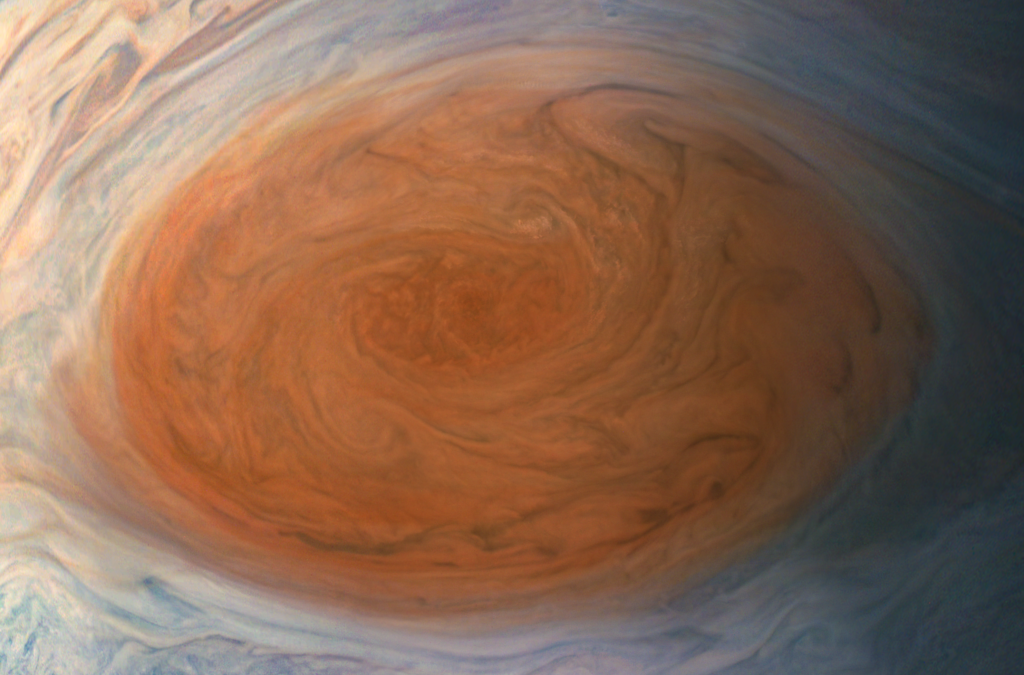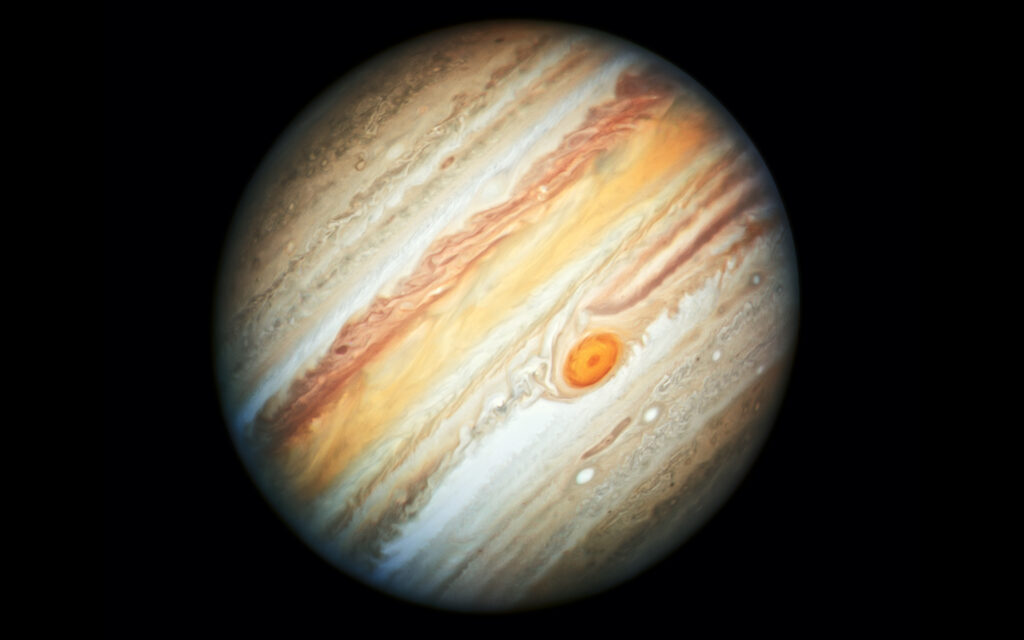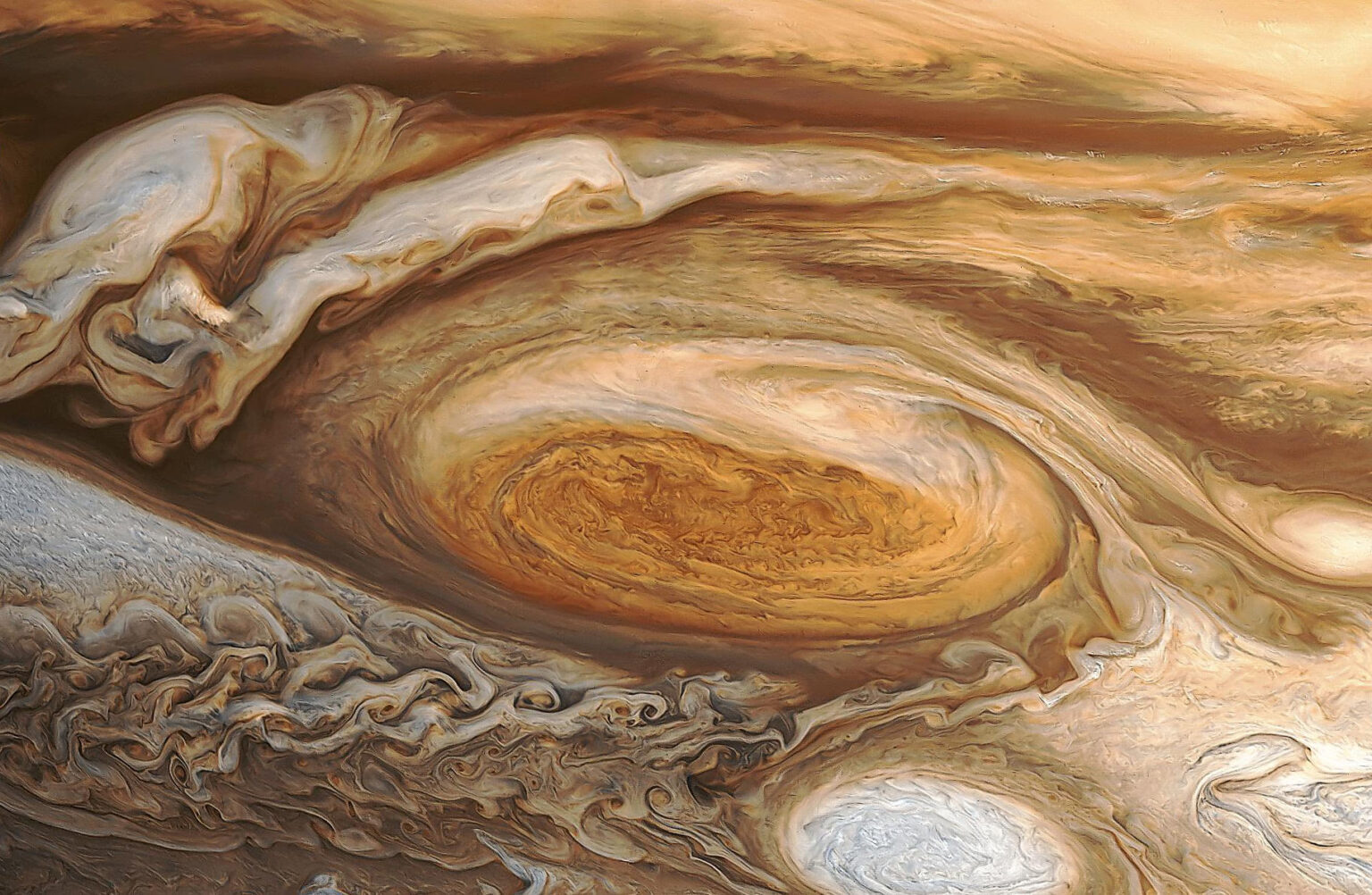Jupiter is the largest planet in the Solar System with absolutely crazy weather. It is enveloped in huge, fast-moving clouds. Indeed, storms are constantly raging on the gas giant. Some of them are larger than the Earth. The largest of them is the famous Great Red Spot.

The Great Red Spot (GRS) is the most famous feature of Jupiter’s surface. This largest vortex storm in the Solar System is anticyclonic in nature — the gases that make up the atmosphere of the giant planet sink to deeper layers in its central regions. The GRS is located between the South Equatorial and South Tropical Belts, its center is constantly at 22° South latitude, and it oscillates in longitude with an amplitude of about 1° and a period of 90 Earth days. One of the systems of Jovian coordinates, the so-called System II, is tied to its center position.
The clouds in the GRS rotate counterclockwise, and their rotation period is currently about 4.5 Earth days. Since the concentration of colored impurities in them (mostly sulfur and phosphorus compounds) increases with depth, the spot acquires its characteristic red-brown color. Despite the fact that the deeper layers of Jupiter’s atmosphere have a higher temperature, the spot does not appear warmer than its immediate surroundings in infrared images. This is probably due to the dynamics of gas movement in the giant anticyclone.
The first mention of observations of the GRS was found in the records of the famous English scientist Robert Hooke, made in 1664. But his data were too contradictory, so the Italian Giovanni Cassini is considered the discoverer of the Jovian storm. He first noticed the spot in 1665 and followed it almost until his own death in 1712.
And then a rather interesting story began. The fact is that in the following years, astronomers seemed to completely stop noticing this huge formation, despite the fact that more and more observations were made and their techniques were constantly improving. The next mention of the GRS is found only on September 5, 1831, and regular observations began in 1879.

Until the end of the nineteenth century, the spot gradually grew, then its size stabilized for several decades: its length exceeded 40 thousand km, and its width (in the meridional direction) reached almost 22 thousand km. Subsequently, the GRS began to decline: slowly at first, and since the 90s of the last century — more and more rapidly. Now its size has almost halved. It is shrinking more slowly in the meridional direction, and scientists believe that by 2040 its shape will change from elliptical to rounded. The color of the spot has also got dimmer in recent years.
What could be the future fate of the GRS? It is quite difficult to answer this question, because it is a unique formation — scientists have never seen anything like it, and therefore have no initial data to make predictions. Cyclonic and anticyclonic storms are constantly occurring in Jovian clouds, but they are all much smaller in size and do not exist for more than a few years. Large vortex structures have been observed on other giant planets: the Great White Spot on Saturn and the Great Dark Spot on Neptune. However, they did not last long either. Instead, Jupiter’s main feature has been adorning it for centuries.
Predictions about the future of the GRS strongly depend on whether the detail observed by Cassini in the 17th and 18th centuries is related to the structure that astronomers have been tracking since 1831. In fact, the connection between them is not obvious, and they could well be different storms in the Jovian atmosphere, one of which disintegrated shortly after the death of its discoverer, while the other formed in the early nineteenth century, experienced maximum power, and is now gradually subsiding before the eyes of scientists. In this case, it has relatively little time left to live — it is quite possible that the world’s largest planet will face the next century without its main decoration.

Recently, there has been some credible evidence to support this theory. In 2019, many observers reported that small light vortices began to break away from the edges of the GRS, which then quickly disappeared. This process continues to this day. It is considered to be one of the signs of the anticyclone’s rapid erosion. Although, as mentioned above, scientists have observed all such phenomena for the first time, so it is difficult to say for sure what they indicate. As of mid-2022, the length of the giant storm still exceeded 20 thousand kilometers and its width reached almost 16 thousand kilometers. It can still be seen through small astronomical instruments with a magnification of at least 80 times so you have all opportunities to make sure that the most famous feature of Jupiter’s cloud cover is in its usual place.

